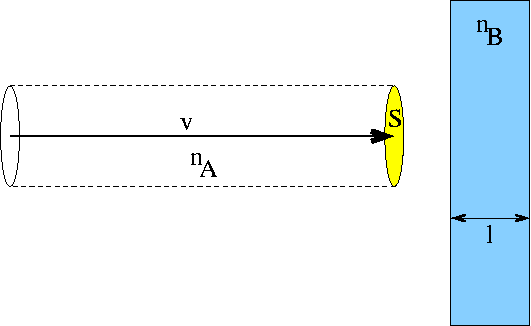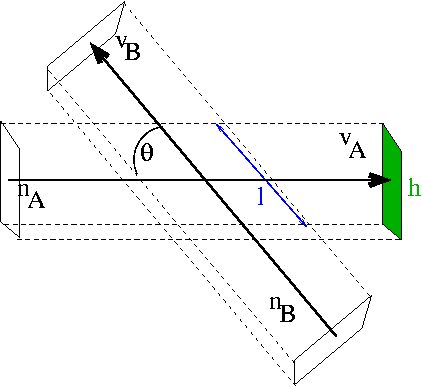Cross section, luminosity, and event rate
CONNECTING CROSS SECTIONS WITH EXPERIMENTS
As discussed above, the cross section is a measure for the probability of a
process to happen. It is entirely specified by the reaction under consideration.
The natural question thus arises, on how this probability translates into visible
scatterings. Clearly, this question is related to the incoming beams, their densities,
mutual orientation and so forth, in short: to the experimental setup. The experimentally
interesting quantity is the rate - frequency - with which events occur. Therefore,
let's try to construct a quantity, which connects the cross section σ and the
resulting event rate R,
 This quantity L is known as the luminosity, it has units of m-2s-1, i.e.
1/(area time). From the defintion of the cross section
the transition (event) rate is connected with the cross section through the number of
scatterers in the target and the incident flux,
This quantity L is known as the luminosity, it has units of m-2s-1, i.e.
1/(area time). From the defintion of the cross section
the transition (event) rate is connected with the cross section through the number of
scatterers in the target and the incident flux,

FIXED TARGET EXPERIMENTS
Consider, once more, the following, classical situation, commonly known as fixed target
experiment: A target consisting of particles of type B is at rest, and is hit by a beam
consisting of particles of type A moving with velocity v w.r.t. the target. Then, in the
lab frame (the frame of the target), the flux Φ is given by
 where n is the density of particles in the beam, which uniformly covers an area of S
orthogonal to the velocity. Per unit area this beam hits the N particles of the target,
where
where n is the density of particles in the beam, which uniformly covers an area of S
orthogonal to the velocity. Per unit area this beam hits the N particles of the target,
where
 and where again n is the density of particles in the target, which has a thickness l.
This is scetched in the figure below.
and where again n is the density of particles in the target, which has a thickness l.
This is scetched in the figure below.
 Thus, the luminosity is given by
Thus, the luminosity is given by
 It clearly has the dimension of m-2s-1.
It clearly has the dimension of m-2s-1.
COLLIDER EXPERIMENTS
The other classical situation is that of a collider experiment, where two beams hit
each other, eventually under an angle θ, see the following scetch.
 To simplify the reasoning, let's assume that both beams have the same flux Φ, and that, also,
both beams have rectangular shape with side length h. Let's take the beam with particle type B as
the target. This does not change anything for the flux of beam A. The only thing to be doen is
to reconstruct the particle area density N in the beam B that is hit by A. From the density
To simplify the reasoning, let's assume that both beams have the same flux Φ, and that, also,
both beams have rectangular shape with side length h. Let's take the beam with particle type B as
the target. This does not change anything for the flux of beam A. The only thing to be doen is
to reconstruct the particle area density N in the beam B that is hit by A. From the density
 N, the density per area, can be calculated as
N, the density per area, can be calculated as
 Therefore, the luminosity reads
Therefore, the luminosity reads
 Note the typical behaviour 1/sinθ and 1/h, the characteristic scale of the beam in
ortohgonal direction.
Note the typical behaviour 1/sinθ and 1/h, the characteristic scale of the beam in
ortohgonal direction.









